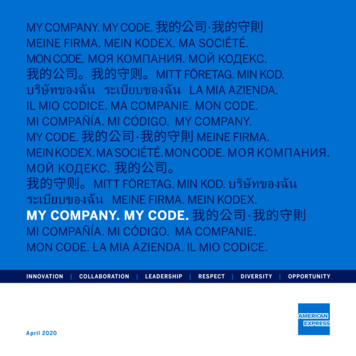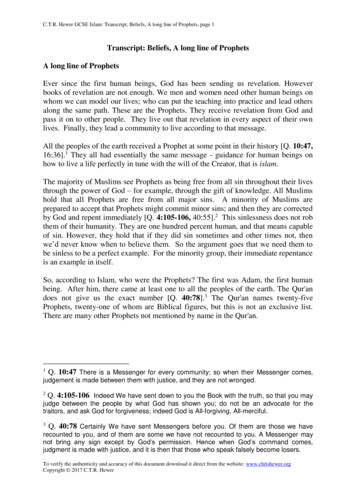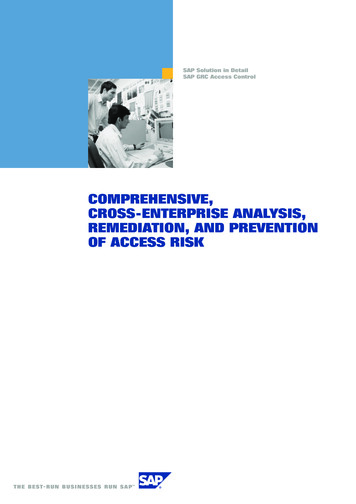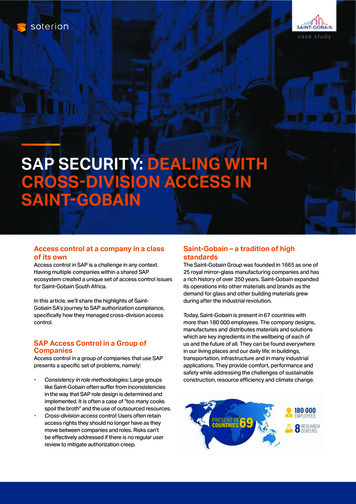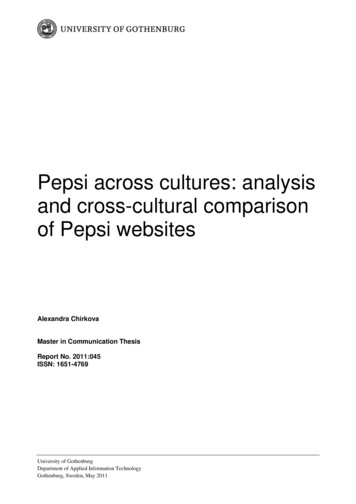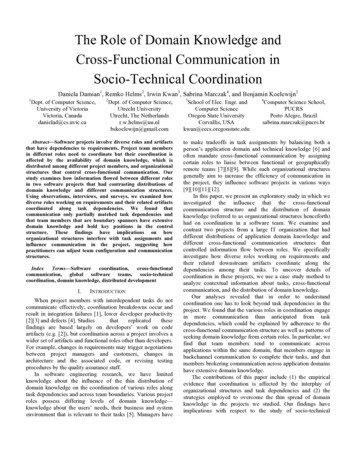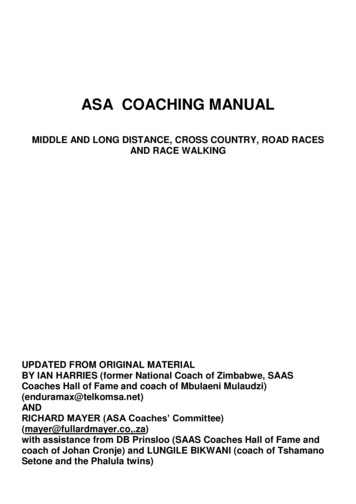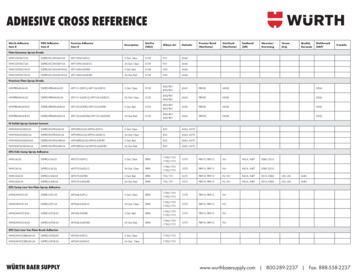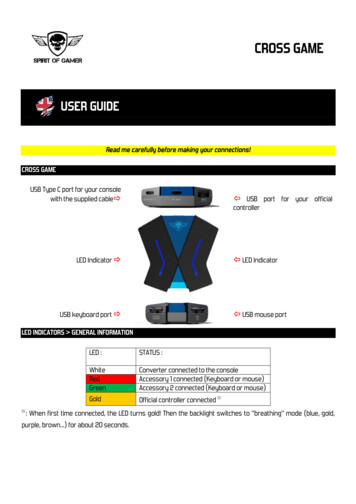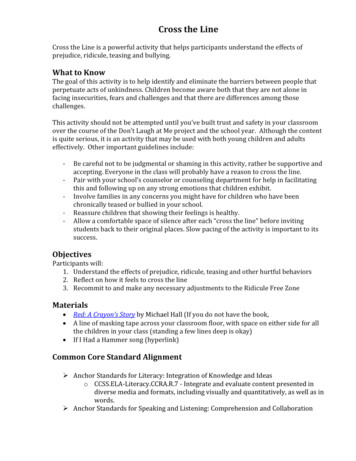
Transcription
Cross the LineCross the Line is a powerful activity that helps participants understand the effects ofprejudice, ridicule, teasing and bullying.What to KnowThe goal of this activity is to help identify and eliminate the barriers between people thatperpetuate acts of unkindness. Children become aware both that they are not alone infacing insecurities, fears and challenges and that there are differences among thosechallenges.This activity should not be attempted until you’ve built trust and safety in your classroomover the course of the Don’t Laugh at Me project and the school year. Although the contentis quite serious, it is an activity that may be used with both young children and adultseffectively. Other important guidelines include:-Be careful not to be judgmental or shaming in this activity, rather be supportive andaccepting. Everyone in the class will probably have a reason to cross the line.Pair with your school’s counselor or counseling department for help in facilitatingthis and following up on any strong emotions that children exhibit.Involve families in any concerns you might have for children who have beenchronically teased or bullied in your school.Reassure children that showing their feelings is healthy.Allow a comfortable space of silence after each “cross the line” before invitingstudents back to their original places. Slow pacing of the activity is important to itssuccess.ObjectivesParticipants will:1. Understand the effects of prejudice, ridicule, teasing and other hurtful behaviors2. Reflect on how it feels to cross the line3. Recommit to and make any necessary adjustments to the Ridicule Free ZoneMaterials Red: A Crayon’s Story by Michael Hall (If you do not have the book,A line of masking tape across your classroom floor, with space on either side for allthe children in your class (standing a few lines deep is okay)If I Had a Hammer song (hyperlink)Common Core Standard Alignment Anchor Standards for Literacy: Integration of Knowledge and Ideaso CCSS.ELA-Literacy.CCRA.R.7 - Integrate and evaluate content presented indiverse media and formats, including visually and quantitatively, as well as inwords. Anchor Standards for Speaking and Listening: Comprehension and Collaboration
o CCSS.ELA-Literacy.CCRA.SL.1 - Prepare for and participate effectively in arange of conversations and collaborations with diverse partners, building onothers' ideas and expressing their own clearly and persuasively. Anchor Standards for Language-Vocabulary Acquisition and Useo CCSS.ELA-Literacy.CCRA.L.5- Demonstrate understanding of figurativelanguage, word relationships, and nuances in word meanings.Gather Together/Warm Up/Bell Ringer: Red: A Crayon’s Story (5Minutes)Read aloud Red: A Crayon’s Story by Michael Hall.Process: “What surprised the other crayons about Red? What did they expect of him becauseof his label? Was this book serious or silly? How do you think the message of this book mightapply to our classroom or our school?”Main Activity: Our Diversity Iceberg and Cross the Line (20 Minutes)Draw a picture of an iceberg and name it "Iceberg of our differences." (Sample below) 10%of the iceberg is above the line: these are the differences about us that we can see. 90% ofthe iceberg is below the line: these are the difference that we can't see.Above the line: size, appearance, gender, age, color, race(sometimes!)Below the line: religion, education, family, ethnicity, beliefs, talents, etc.Introduce the activity:“This activity is called "Cross the Line" and asks us to remember experiences we've hadwhere we may have been treated badly or unkindly.”Explain some important agreements you’ll need to make as a class before beginning:-We will do the activity in complete silence (no laughing or talking); we can talkabout it when it’s over.Some strong feelings might come up like sadness or anger. Remember, all feelingsare important. We need to be respectful and caring about one another’s feelings sothat everyone feels safe while we do this activity.
Ask everyone to move to the masking tape line on the floor facing in the same directionbehind it. Explain how to do the activity:“I’m going to call out an experience and if you have had that experience, please cross theline and turn around to face the students on the other side of the line. If you do not feelcomfortable crossing the line, even though you are part of that group, that’s okay. You canstay right where you are and notice any feelings you are having.” For each experience youcall out, people who have had that experience will cross the line. They will then turnaround to face the students who have not crossed the line. When you tell the group thatcrossed the line to return, they will return to their original places on the other side ofthe tape, so that the entire group is standing together once more.After each of the “cross the line” categories, you will:1) Pause until the students who have crossed the line have turned to face the otherstudents;2) Then you will say: “Now notice how it feels to cross the line and notice how it feels towatch other people cross the line (pause.) Notice who is with you (pause). Notice who isnot with you (pause);”3) Ask everyone to come back together behind the masking tape.“Now, cross the line in silence if you’ve ever been teased or called a bad name or made funof.”“Cross the line if you’ve ever felt left out because you’re a girl.”“Cross the line if you’ve ever been called a mean name or put down just because you’re agirl.”“Cross the line if you’ve ever been called a mean name or put down just because you’re aboy.”“Cross the line if you’ve ever felt left out because you’re a boy.“Cross the line if you’ve ever been told you should not do something or like somethingbecause you are a girl?”“Cross the line if you’ve ever been told you should not do something or like somethingbecause you are a boy?”“Cross the line if you, or someone you care about, has ever been judged or teased becauseof the color of your (or his/her) skin.”“Cross the line if you’ve ever been teased about your accent or your voice, or told that youcouldn’t sing.”“Cross the line if you or any one of your family members or any friends of yours has adisability that you can or can’t see.”
“Now cross the line if you’ve ever seen someone else being teased or called a bad name ormade fun of.”“Cross the line if you’ve ever been told you shouldn’t cry, show your emotions, or be afraid.”“Cross the line if you’ve ever felt alone, unwelcome, or afraid.”“Cross the line if you or someone you care about has ever been teased or made fun of forwearing glasses, braces, a hearing aid, or for the clothes you wear, your height, yourweight, your complexion, or the size or shape of your body.”“Cross the line if you’ve ever felt pressure from your friends or an adult to do somethingyou didn’t want to do and felt sorry or ashamed afterwards.”“Cross the line if you’ve ever felt ashamed for speaking from your heart or sharing yourworries, fears, or secret hopes and dreams with someone.”“Cross the line if someone’s ever been mean to you and you’ve been reluctant or too afraidto say anything about it.”“Cross the line if you’re ever stood by and watched while someone was hurt and said or didnothing because you were too afraid.”Process in the large group:What feelings did you have during this activity?What was the hardest part for you?What did you learn about yourself? About others?What do you want to remember about what we’ve just experienced?What, if anything, do you want to tell others about this experience?”Closing Activity: If I Had a Hammer Integrated Arts (5 Minutes)Introduce the closing activity:"This is our fourth cornerstone theme. We are recognizing that human beings are not alwaysnice to each other and that sometimes our differences are used against us, but from the otherthemes we know that we can become upstanders for each other. We can support each other."Process:“What did you learn from this activity that can make our classroom and school morewelcoming?”End by listen to or singing "If I Had a Hammer" together. Make the point that ourcommitment to being an upstander can be our hammer—or one of the tools that we use tocreate a community we all want to thrive and learn in. Are there other tools?
Grade Level ModificationsK-1 Instead of having students stand up and “cross the line,” it may feel safer for youngerstudents to sit in a circle for this activity. Their participation could be modified so thatstudents are given a card with a large green dot on one side and a red dot on the other. Iftheir answer to the question is yes, they lay the green side facing up in front of them; if it’sno, the red side faces up. The questions would then be reframed as, “Have you ever been .”instead of “Cross the line if .”Limit the number of questions to the first seven or eight in the core lesson, as many of theothers will not be developmentally appropriate for this level. You may want to add orsubstitute:“Have you ever been told that you couldn’t play in a group of children on the playground?”“Have you ever been told you couldn’t play in a group of children because you are a girl or aboy?”Follow the instructions for grades 2-5 for the rest of the activity.Grades 6-12 and AdultsDo the activity as outlined. You may choose to substitute or add additional experiencesbased on particular issues within your community (For instance, “Cross the line if you orsomeone you care about has been ridiculed or left out because they are/or are believed tobe: gay/lesbian/bisexual/transgendered; Christian/Jewish/Muslim/Atheist; etc.Curricular ConnectionsK-12 Literacy and Art: Using Todd Parr’s It's Okay To Be Different, have students createoversized paintings in the colorful style he uses. Point out to students the bold outlines heuses, the simple illustrations, and how there is little if any white space left in hisillustrations. Make a chart that says, “In our classroom (school), it’s okay to .” andbrainstorm with students a list of silly and serious differences. Then, students can use oneof the ideas from the list, or make up their own and write it on a sentence strip. On largeart paper, have students paint a picture to illustrate their idea.K-5 Literacy: Read Whoever You Are by Mem Fox. In the book there is a gentle beingguiding children around the world to see that although there are many differences amonghumans, “hearts are the same.” Have students use the text as a starting point for their ownpoems about this message. Poems can start with “Little one, whoever you are, whereveryou are, there are others that ” Share poems with another class or another grade.K-5 Literacy and Art: Read The Colors of Us by Karen Katz. Using “multicultural” or “peoplecolors” paint have students mix colors until they match their own skin color. Students cando this on art paper or they can mix the paint directly onto their skin. Have students namethe color of their skin. Once they have a match, students can paint a tracing of their hand.The hands with their self-chosen color name can be displayed around the room. (NOTE:This is a good place to introduce the issue of “flesh” colored crayons and what that tells usabout how people view diversity.)
6-12 Literacy. Set in Mississippi at the height of the Depression Roll of Thunder, Hear My Cryby Mildred D. Taylor explores the life of the Logan family, who must live in fear because thewhite people in the community do not see black people as equal. Explore examples ofdiscrimination in the book and look for examples in students’ lives as well.6-12 History and Literacy: In Anne Frank: The Diary of a Young Girl, Anne says, “I stillbelieve people are basically good,” even though her life is in peril because of prejudiceagainst Jewish people during the Holocaust. Have students discuss this quote in apair/share. Do you think that people are basically good? If yes, what, if anything, in your lifehelps you to keep your faith in the basic goodness of people? If not, what in particular mostdiscourages you from believing in the basic goodness of people?6-12 Music and Integrated Arts: Discuss how music has been used over time to create socialchange. What examples do you think were most effective? How has art been used to createsocial change? Speech? Listen to some of the music provided through the Don’t Laugh at Meprogram and research its use to support social change.6-12 Industrial Arts: Create hammers and other tools that represent things you want tokeep in your Don’t Laugh at Me toolbox: an ear for an ability to listen; a giant “I” for Istatements; a U to remember to be an upstander; etc. Display this tool kit in a central placein your school or town/city hall with captions explaining their function. Spread the RFZ!
Cross the Line Cross the Line is a powerful activity that helps participants understand the effects of prejudice, ridicule, teasing and bullying. What to Know The goal of this activity is to help identify and eliminate the barriers between people that perpetuate acts of unkindness. Children become aware both that they are not alone in
